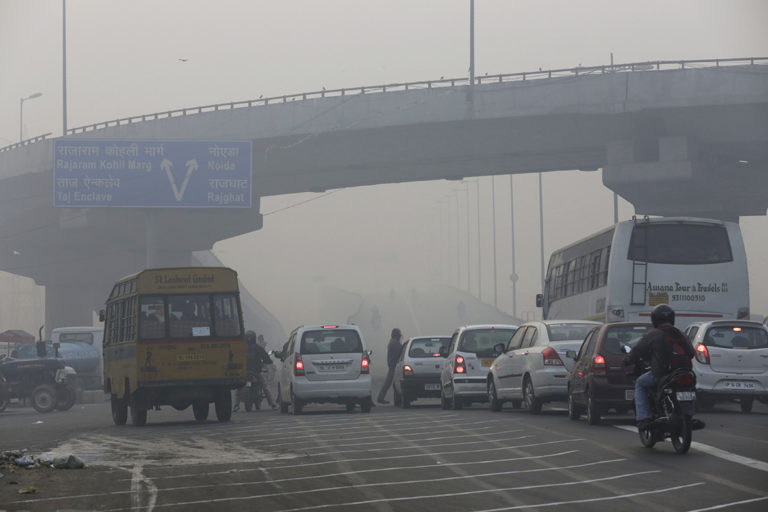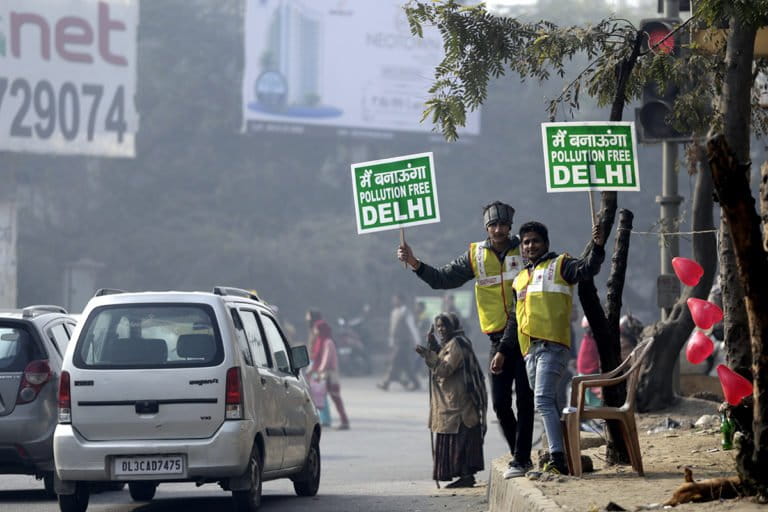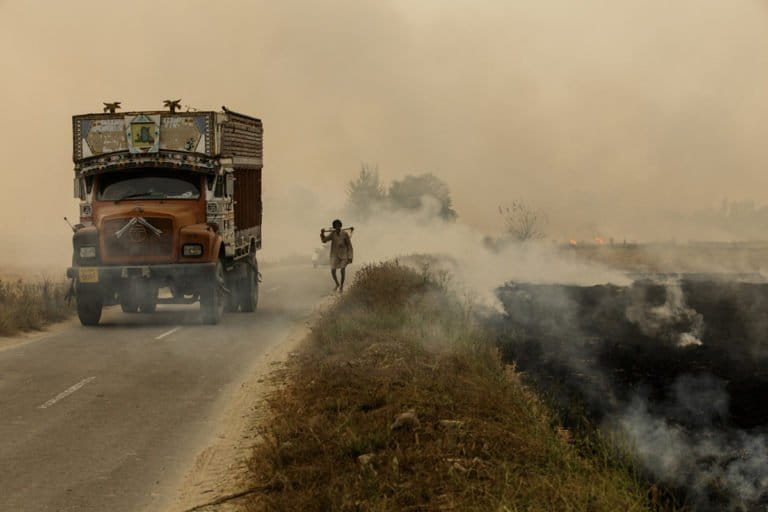- A report has declared improved air quality in Delhi, adding that the capital still needs to cut pollution by 65 percent to meet acceptable air quality standards.
- Political parties have been claiming credit for the reported improvement in air quality, indicating that air pollution may become a prime issue during assembly polls scheduled for next year.
- However, some experts have questioned the accuracy of the analysis showing improvement in air quality, citing gaps in data availability and variance in meteorological conditions over the years.
Within six weeks of the release of an expert analysis that declared a 25 percent reduction in the pollution levels of Delhi, India’s national capital is once again in the grip of severe pollution. Meanwhile, there is a race among politicians of different parties to stake a claim on the reduction in pollution. Citizens of the national capital are hoping this political race translates into more focused and serious efforts to control the pollution.
Recently, in the second week of October, air quality in Delhi dropped to the “very poor” category, raising the prospects of toxic levels of air quality, especially given that it comes just a couple of weeks ahead of the Diwali festival when the burning of crackers aggravates the situation. Delhi’s Chief Minister Arvind Kejriwal has already appealed to Delhiites to enjoy a free laser show it has organised in the central area of Connaught Place, during Diwali, instead of burning crackers.
The burning of crop stubble by farmers during this time every year is also touted to be behind the sharp rise in pollution in Delhi and its adjoining areas like Ghaziabad, Noida, Gurugram and Faridabad.
Kejriwal, who leads the Aam Aadmi Party (AAP), announced a seven-point programme to fight air pollution. Besides the free distribution of anti-pollution masks to citizens of the city, his charter included bringing back the odd-even vehicle rationing scheme — where odd and even numbered vehicles ply on alternate days — as an “emergency measure”. The scheme will be executed next month between November 4-15, 2019.
“The studies about odd-even (scheme) show that it reduces pollution by 10-13 percent. So, we are taking the step as an emergency measure,” said Kejriwal while announcing the seven-point charter.

The central government and the Delhi government have been at loggerheads on many issues and disagreements over air pollution may set the tone for the upcoming assembly polls scheduled for early next year. Kejriwal, while announcing the odd-even car rationing scheme, “exempted” ministers of the central government but made it mandatory for his own ministerial colleagues and himself to follow the scheme. The step is being seen as a move to score a political point while combatting pollution.
Since the analysis showing reduced pollution in the city has come out, the AAP-led government have been staking a claim on it. However, the Bharatiya Janata Party (BJP) leaders who are in power at the centre, have been countering his claims stating that the central government had a major role in the reduction of pollution levels in the city.
Once the pollution levels started rising again, Manoj Tiwari, chief of Delhi BJP, distributed masks among people to target Kejriwal government. He said the state government has failed in tackling the problem of pollution.
Union Minister of Road Transport and Highways Minister Nitin Gadkari too dismissed the need for the odd-even scheme by Kejriwal. Gadkari said that the central government has taken enough steps to fight air pollution and this problem of the national capital will be fixed in the next two years.
When Kejriwal was invited to participate in the C-40 World Mayors Summit in Copenhagen, Denmark recently, he was denied permission by the BJP-led central government. However, Kejriwal still participated via video conference and pledged to fight air pollution by signing the C-40 Clean Air Declaration.
In his latest message on the issue, Kejriwal on Sunday (October 20, 2019) tweeted, “Delhi elections will take place on the issues of schools, hospitals, elect, water, dengue, pollution, CCTV etc. Good signs for Indian democracy.”

People welcome the steps to tackle pollution and competition among politicians
This alacrity is new among politicians in Delhi, as they compete to take credit for the drop in pollution levels. Delhiites have welcomed this, hoping the issue of air pollution will dominate the upcoming assembly elections, scheduled early next year. The city and its adjoining regions bear a notorious tag of being the worst polluted region of the world.
“I am happy that the issue of air pollution is being discussed before the polls. I want this election to be fought on such issues that affect our life and health,” said 22-years-old Kum Mero, a student of the Ambedkar University of Delhi.
Issues like women’s security, corruption and granting of full statehood to Delhi have usually been a prominent part of the election manifesto of political parties while air pollution has remained on the back burner.
Over the past few years, air pollution in the city has become an active part of people’s consciousness, especially during the winter season, starting from Diwali. People wearing protective masks on a daily basis as well as during outdoor events like a half marathon are common.
“I would like the environment to be the core issue of Delhi election this time and I would actually want the next government to have proper planning of waste management as the random burning of garbage also causes a lot of air pollution,” said Jai Kumar, a student who lives in New Delhi.

How is air pollution being tackled?
In August 2019, Delhi-based think tank Centre for Science and Environment (CSE) concluded that air pollution levels have dropped by 25 percent (air quality has improved) between 2012-14 and 2016-18. The CSE analysis had also said that Delhi still needs to cut the pollution levels by 65 percent to meet the air quality standards.
After this Chief Minister Arvind Kejriwal congratulated Delhiites for this “success” in curbing pollution.
In July 2019, the Union Minister for Environment, Forest and Climate Change Prakash Javadekar too had tabled data in the parliament to show that air has become cleaner in Delhi. He claimed that the number of “poor” air quality days has gone down by 33 percent in Delhi and its surrounding areas.
There is debate among policymakers as to who is actually responsible behind efforts in bringing down pollution levels. Under the watch of the Supreme Court of India, which has passed several orders over the past few years to tackle air pollution, a series of actions have been taken to address air pollution. While some actions have been taken by the central government, some have been taken by the Delhi government and some by local municipal bodies.
Some of the actions include phasing out all the big industries out of the city over the last 20 years, shifting entire public transport and small commercial vehicles to Compressed Natural Gas (CNG), shutting down of all coal power plants of Delhi and action against brick kilns.
Steps like banning of coal, pet coke and furnace oil, use of cleaner petrol and diesel, restriction on entry of old trucks in the city and measures to control dust have also contributed to reduction in air pollution.
“So, you can imagine with all of that (the steps taken to cut air pollution) we have able to shave off only the peak pollution but now imagine what is needed? We have to understand for the next 65 percent reduction the scale of action, stringency of action, enforcement, compliance, deterrence and penalty … That really will have to be our third-generation measure to get clean air,” Anumita Roychowdhury of the Centre for Science and Environment (CSE), a Delhi-based environment think-tank, told Mongabay-India.

Not so clean air
While politicians have latched on to the reduction in pollution levels to showcase their efforts, questions have been raised on the claims of 25 percent dip in the air pollution of the capital. Some experts argue that it is not possible to draw a comparison between 2012-14 and 2016-18 because there is a large gap between data availability, very few continuous monitoring stations before 2015 and the wide variance in the meteorological conditions.
“What would be ideal is if there is an official analysis that’s out in the public domain. That (should be) systematic, transparent and replicable… which means (the analysis) systematically compares (pollution) monitors across the years, transparent about the steps and data that is being used in public domain and is replicable by any interested citizen,” said Harish Santosh of the Centre for Policy Research (CPR), a Delhi-based public policy think tank.
According to the State of Global Air Report (SoGA) released earlier this year, 1.2 million people die prematurely in India due to air pollution. The Lancet report published in 2017 stated that every year 12,322 people died in Delhi prematurely due to the ailments related to air pollution. Another report says that in 2016, 14,800 people died in Delhi prematurely due to exposure to fine particulate matter.
In January 2019, the Indian government launched a National Clean Air Programme (NCAP) which includes 122 major cities and targets to cut down the pollution by 30 percent by 2024 and by 50 percent by 2030.
“We have moved far beyond of NCAP. Other states have not implemented it yet. We are doing double than what the Supreme Court has asked to do or the NCAP tells us to do. These programmes keep coming on papers but the real work depends on your intent. We have shown the intent and we have complied with all the orders and done well,” said Arvind Kejriwal, when Mongabay-India asked about a weak NCAP, indicating that he intends to bring it up in the election narrative.

Banner image: (Representational) Recently, in the second week of October, air quality in Delhi dropped to the “very poor” category. Photo by Vikas Choudhary/CSE.
